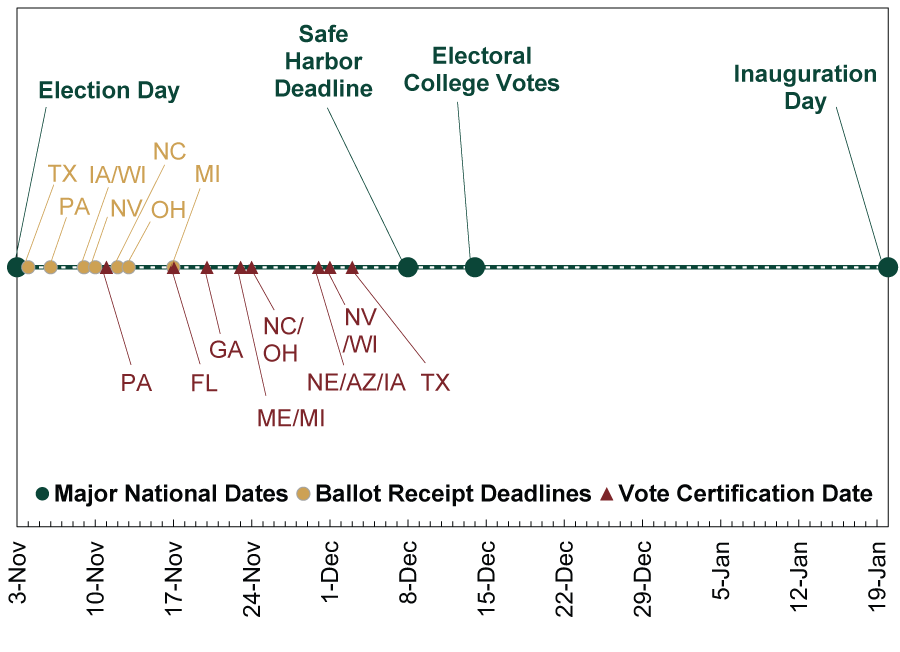Personal Wealth Management / 2020 Election
Election Clarity: Possibly a Bit Delayed, but Still Coming Soon
The ins and outs of the timeline after November 3.
Editors’ Note: MarketMinder is intentionally nonpartisan. We favor no political party or politician and assess political developments solely for their potential economic and market impact.
T-minus 14 days to Election Day, when we will finally know … well, perhaps not much. With several states slated to take days (or weeks) to receive and count mail-in ballots and both parties already lawyered up, unless there is a massive landslide in the initial tally, we are almost certain to face several days of extended uncertainty over whether President Donald Trump or former Vice President Joe Biden will be inaugurated next January. Pundits have warned for weeks of chaos and a host of outlandish possibilities, arguing sharp market volatility (or worse) is a virtual certainty. We always encourage investors to brace for wobbles—not because we expect them, but because volatility can arise at any time, for any or no reason. Regardless, we think investors would benefit from approaching the election with clear-eyed expectations of how election clarity will likely unfold.
COVID has had a huge impact on each party’s voter turnout strategy, making this election like none we have ever seen. The Republican Party claims to have built the biggest ground game in its history, reportedly with 1.5 million trained field workers knocking on doors, registering voters and helping people get to the polls on November 3. But the Democratic Party can’t go this traditional route, as it would conflict with the way its leaders have responded politically to the pandemic. You can’t make social distancing a key issue and then knock on doors and volunteer to drive people to the polls. So instead of the traditional ground game, they have deployed their considerable war chest on an “air game”—TV ads and other channels to encourage mail-in voting. The result will largely hinge on which effort is more successful. Will Republican turnout offset Trump’s relatively weak personal polling in toss-up states? Or will Democratic turnout tilt the playing field toward Biden?
Because Biden and Democratic Congressional candidates are expected to win the majority of mail-in ballots, a Biden sweep on Election Day would make his victory a virtual certainty. But if Trump is ahead on election night, then the delays set in. The Democrats’ strategy has put more states and regions in play than usual, and, based on Real Clear Politics’ tally there are 12 whose electoral votes could go either way. As Exhibit 1 shows, nine of them have ballot due dates after Election Day provided they are postmarked by November 3. From there, the final vote certification deadlines range from November 11 (Pennsylvania) to December 3 (Texas).
But the real deadline is December 8, the so-called Safe Harbor Date, which is the final day on which states can select electors with guaranteed Congressional acceptance. That is the date courts will keep top of mind when deciding lawsuits over recounts in close states. In 2000, the Safe Harbor date was December 12—the very date the Supreme Court ruled in Bush V. Gore. Florida Senator Marco Rubio made headlines in August for submitting legislation to move this date to January 1 (and the Electoral College vote to January 2) in order to accommodate COVID-related delays, but that seemed mostly to us like political showmanship. The Senate seemed to agree, as the legislation went nowhere. We suspect this is partly because several states have enshrined that date in their own laws, setting up even more lawsuits if the Senate monkeyed with the calendar, and partly because it is just plain unnecessary.
Exhibit 1: Swing State Electoral Timeline
Source: Vote.org, National Council of State Legislatures, Secretaries of State, NPR, The Washington Post and Fisher Investments Research, as of 10/9/2020. Maine and Nebraska aren’t swing states, but they award their electoral votes to the winner of the state overall and each congressional district separately. Each state’s second congressional district is considered swing.
It is worth noting that many of these dates are undergoing legal challenge and are subject to change. Pennsylvania’s November 6 ballot receipt deadline was upheld by the Supreme Court on October 20, but Michigan’s extended deadline—still depicted here—was reversed by an appellate court last week. We have chosen to leave it at the extended deadline here for two reasons: One, further legal challenge is possible. Two, it serves as the latest possible date any swing state would accept mail-in ballots postmarked prior to Election Day. At any rate, please know many of the extended deadlines here could still revert to Election Day. They could also remain as-is. But either way, by mid-November, any ballot that is going to count must be in.
While there are 12 swing states and regions on this calendar, that doesn’t mean we expect 12 sets of recounts and court challenges. Not all will be close enough to warrant it. For example, Ohio was a swing state in 2016, but Trump won it by 8.1 percentage points. Swing didn’t mean close, and it often doesn’t. By contrast, Florida’s recount happened in 2000 because President George W. Bush’s initial margin of victory was less than 0.5% of all votes cast. We aren’t saying that is a threshold for lawsuits and recounts this time around, but it gives you a sense of how close the margins need to be.
As for how the lawsuits themselves will play out, there is already a lot of evidence that the process will be orderly. Namely, the slew of ongoing legal challenges tied to the election. Yesterday, the Supreme Court split 4 – 4 on Pennsylvania’s mail-in ballot receipt deadline extension, leaving it at November 6. There are several more like this, and we think you can consider them a preview of potential post-vote challenges. They will garner headlines and spur a ton of chatter, but courts will expedite the cases and rule swiftly and transparently.
Some point to 2000 as evidence a delayed result and the associated legal challenges are auto-negative for stocks. But in our view, the critical factor for stocks at that time was the sheer surprise. Entering the election, no one expected the Electoral College to hinge on Florida’s 25 electoral votes, and polls showed Bush a few percentage points ahead of then-Vice President Al Gore. Having the results hinge on one state that toggled from blue to grey to red to grey on Election Night was new, and then markets had to deal with the unprecedented scrutiny of “hanging chads” and other cable news fodder. The overall newness, plus the fact stocks were already in a bear market that began the prior March, is likely what contributed to the volatility. This time, there is no surprise power. Pundits have warned of lawsuits and delayed results. Some even go so far as to warn of a Constitutional crisis if the loser refuses to accept the result (a theory we find far-fetched). The abundant chatter makes it exceedingly likely there is no scenario, even a very extreme and highly unlikely scenario, stocks haven’t already considered.
Hence, we recommend viewing the next few weeks as markets do and remembering that, whatever happens in the interim, we should know the winner by mid-December at the latest, and whoever it is will be inaugurated on January 20. Regardless of who specifically takes the oath of office, the coming clarity should be a tailwind for stocks.
If you would like to contact the editors responsible for this article, please message MarketMinder directly.
*The content contained in this article represents only the opinions and viewpoints of the Fisher Investments editorial staff.
Get a weekly roundup of our market insights
Sign up for our weekly e-mail newsletter.

You Imagine Your Future. We Help You Get There.
Are you ready to start your journey to a better financial future?

Where Might the Market Go Next?
Confidently tackle the market’s ups and downs with independent research and analysis that tells you where we think stocks are headed—and why.






